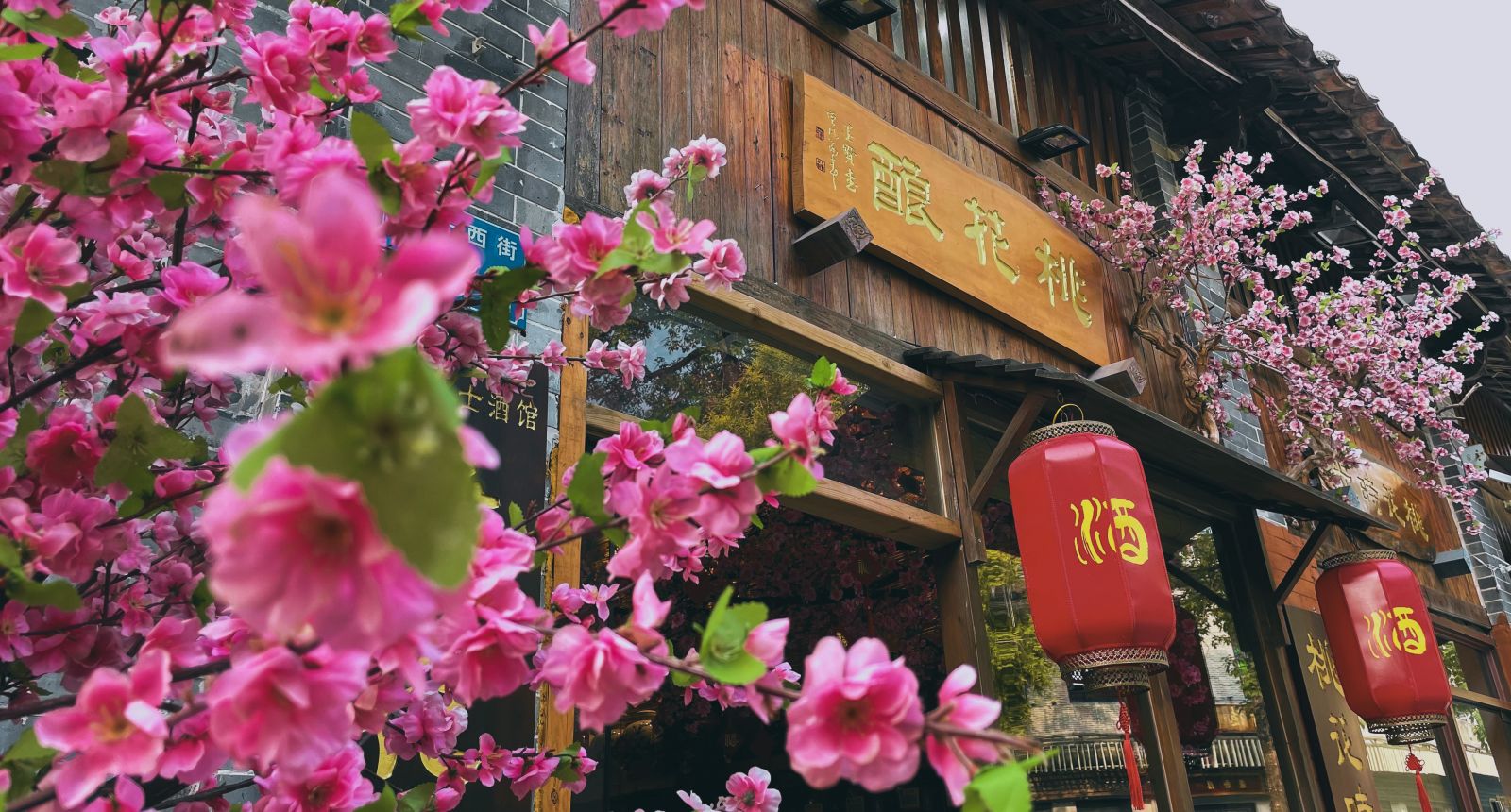Chinese Name: 沙湾古镇 Pronunciation: shā wān gǔ zhèn
Recommended Time for Visit: One Day
Address: No.10, Daxiangyong Road, Shawan Town, Panyu District, Guangzhou City
Occupied Area: About 1.53 square kilometers
Building Time: The Southern Song Dynasty (1127-1279)
Best Visiting Season: Spring and autumn (March to May, September to November)
| Visitors | Price |
| Adults (aged 19-63) |
30 yuan |
| Children (1.3-1.5 meters or aged 7-18) |
15 yuan |
| Seniors (aged 60-64) |
15 yuan |
1.Children below 1.2 meters; Children aged 6 or younger than 6;
2.Seniors aged 65 or above;
| Shawan Ancient Town | All Seasons |
| Gate Opening Hours | 9:30-17:30 |
| Ticket Office Opening Hours | 9:30-16:30 |

The Shawan Ancient Town, located in Panyu District, the midwest of Guangzhou City, was built in the Southern Song Dynasty (1127-1279). The town boasts a history of over 800 years and features the architectural style of South China.
The Shawan Ancient Town is honored with many titles such as “Hometown of Chinese Folk Art”, “Hometown of Cantonese Music”, “Hometown of Folk Art in Guangdong Province”, “Hometown of Folk Sculpture” and “Ancient Village in Guangdong”.
The town is a typical southern water town in the Pearl River Delta region. Relying on its beautiful view and rich cultural heritage, it has developed into an attractive scenic spot. The town has around 48.9 hectares’ historical and cultural construction protection area, which consists of the east village, the west village, the north village and the south village.
When walking into the Shawan Ancient Town, visitors could find the historical trace of the town’s development. The town looks primitive and elegant in general. Rows of houses, old streets, and long alleys were built on black stones, which look like a real ancient town. Tourists here will see as many as 100 ancestral halls. And folk arts and cultures are still booming. Tourists would enjoy some intangible cultural heritages, such as Cantonese folk music, the lion dance, and Piaose (飘色) (a kind of folk art in Guangdong comprising play, magic, acrobatics, music, and dance).
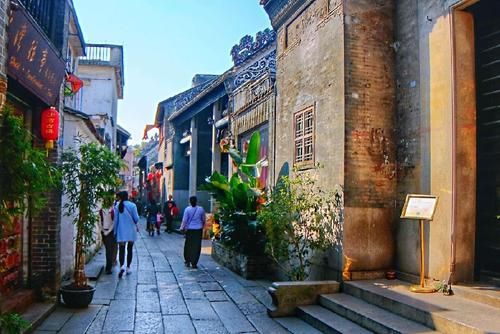
There are twenty-six two-floor traditional shops featured with “living room above, business below”, such as “Wonton House”, “Photo studio”, and “Barbershop”. Besides, some snack bars and pubs also swarm into the town.
In terms of cuisine, Shawan ginger milk is well-known in Hong Kong and Macau. Traditional dishes such as shredded chicken stuffed with sprouts, black pepper geese, and milk feast are also worth a thumb-up.
The new panorama of the Shawan Ancient Town would overwhelm tourists. The town retains its original aura and presents an eye-catching town appearance with improved modern facilities.
All above fully demonstrate the abundant historical and cultural heritage of the Shawan Ancient Town. Besides, the town also introduces a relaxing experience, including all kinds of daily activities.
In the town, tourists would enjoy themselves. They would listen to melodious Cantonese music, drink tea, taste the unique delicious snacks of Shawan, and come upon the shock between modern culture and traditional culture. It is indeed an unforgettable experience.
A large number of ancient buildings, including ancient ancestral halls, temples, and ordinary houses, were built during the times of the Ming Dynasty (1368-1644), Qing Dynasty (1636-1912), and the Republic of China (1912-1949). Many of them remain their original images. The town is a remarkable representative of Cantonese culture in the center of the Pearl River Delta.
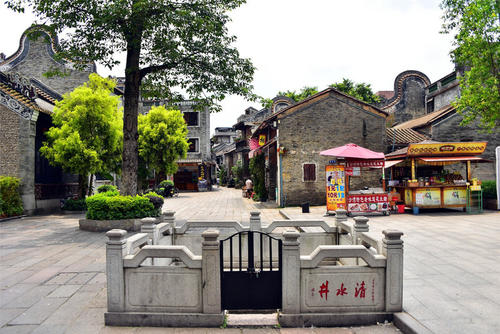
The Qingshui Well is a landmark-a square ancient well made of white granite with a depth of 1.5 meters, a width of 3 meters, and a length of 4 meters. It was said that the well was made 200 years ago. The well consists of a big well and a small well that are separated by a stone wall. Also, stone stairs are available in the southeast corner for people to fetch fresh water. Clean running water still nourishes this town.
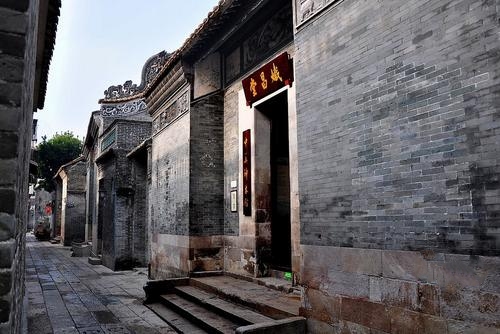
Tourists must see the most dazzling treasure here-a set of porcelain plates painted with 108 heroes’ portraits in the Heroes of the Marshes (水浒传), one of the four most well-known Chinese novels in ancient times. This set is one of the original three sets that were finished in 1951, and the second set is stored in the State Russian Museum and the plates of the third set are scattered across China.
The set of porcelain plates would present visitors with a dazzling “plate-scroll” that shows Chinese tradition and incredible porcelain-making techniques.

The Chinese Shenmu Furniture Hall features its delicate artworks and furniture that are made of ebony, a precious wood enjoying a nickname of ‘mummy of plants’. It is estimated that this kind of wood grew in the primary forests hundreds of thousands of years ago. The wood, thanks to its elegance and quaintness, is a perfect material for making artworks and furniture.
In ancient times, high-ranking officials and refined scholars all regarded Shenmu (ebony) furniture as a family treasure and a thing dispelling evil spirits. And there is a saying that “Cherish a piece of ebony, not a box of jewelry” (纵有珠宝一箱,不如乌木一方).

The Liugeng Hall, also named the Grand Ancestral Hall of the He Clan, is a landmark building in the Shawan Ancient Town. Although the hall was devastated many times in history, the hall was renovated in 1720. The hall, covering a 3334-square-meter area, is the largest ancestral shrine of the He Clan, a literary family.
Before walking into the hall, tourists may be amazed at two painted strong door gods on each side of the gate. When walking further, tourists will see a high majestic stone arch. And then the grand Xiangxian Hall comes into view. In front of the hall is a platform where ancient people worshiped deities to welcome the coming favorable weather.
Galleries are situated on the east and the west side, exhibiting various rare cultural relics to tourists. Dense horizontal tablets that record the honors and achievements of the He Clan in ancient times are displayed in the Xiangxian Hall. Behind the hall stands the famous Liugeng Hall. The exquisite sculptures make the building more delicate.
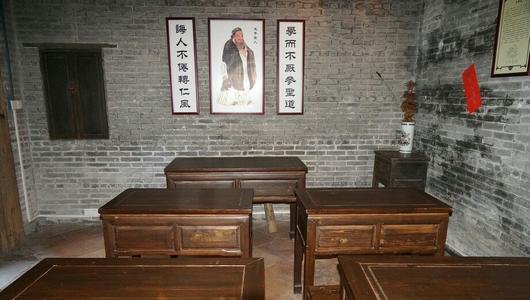
The Study Room in the town follows the style of a private school in the mid-Qing Dynasty (1644-1911): three rooms with two corridors, in which rows of desks and chairs are placed in order. “Chinese four treasures in study rooms” are arranged on the desks. In the past, Confucian texts and enlightening education are the main courses in the study room, and the room is also a vital part of the imperial examination system, which shows that the Shawan Ancient Town paid enough attention to education. When tourists visit here, they might imagine a scene: young students used to study day in day out in this room.
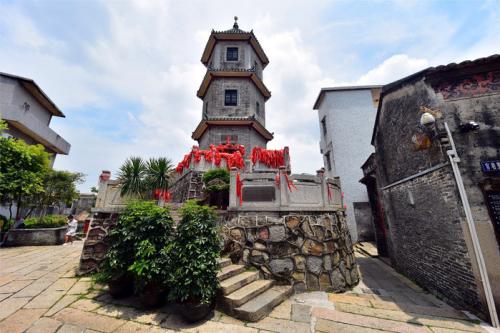
The Wenfeng Pagoda, built in 1721 and used to be the tallest building in the town, is attached to the Liugeng Hall and also a Fengshui (风水) pagoda (Fengshui aims to use energy forces to harmonize individuals with the surrounding environment). The statue of Wenkuixing (文魁星), the Master of Study, is enshrined inside. The original purpose of the pagoda was to inspire young people to study hard. Every year when a new semester starts, scholars and students would come here to pray for success in their studies.
When entering West Anning Street, the first site is the Sanren Hall. The name is from an old sanren tree planted in the backyard. Being built more than 100 years ago, the hall was originally aimed to be an ancestral hall of the wealthy He Clan.
However, the original purpose did not come true. Later on, He Clan descendants who engaged in the music field often came here to play Cantonese music. Sometimes they also invited some music lovers from other provinces and had a talk about Cantonese music here. A lot of widely known Cantonese songs were composed at that time.
There are three portraits of three prominent He Clan descendants in the hall. Therefore, the Sanren Hall is also the birthplace of typical Cantonese music. Tourists not only listen to the melodious tune of original Cantonese music but also admire the old instruments.
There is an allegorical saying in Guangzhou called “Shawan Lantern-Why so suffering (何苦hé kǔ)?” (Suffering means “kǔ (苦)” in Chinese, and “kǔ” similar to “fǔ” in Cantonese pronunciation, “fǔ” has the same pronunciation “府” (house).
It was said that the He Clan owned a lot of land and property. When people go to Shawan, most of the large lanterns hanging in front of the door are written with the character “He Fu”(House of He Clan). It turns out that in the past, big households used to hang out lanterns with their family’s surname when night falls. Since then, people have said that “the lanterns hung in Shawan are written with ‘He Fu’ more often”.
In Cantonese, “fǔ” and “kǔ (suffering)” are homophones, so this sentence is a pun, and it becomes a question “Why so suffering?”
Daxiangyong Road →Qingshui Well →Renrang Gongju →Yanqing Hall →Chebei Street →Gaorui Alley →Youqi Hall →Chichang Hall →Former Residence of He Shaoxia → Guanyin Hall →Ancient Wall →Liugeng Hall →West Square →Dama Alley → Agriculture Life Museum →Wenfeng Tower →Study Room →Zhennan Ancestral Hall →Sanren Hall
Take bus Pan 6, Pan 7, Pan 12, Pan 67, or Pan 68, and get off at the Wentizhongxin Station.
Chinese: 请带我去沙湾古镇。English: Please take me to the Shawan Ancient Town.
Chinese: 请带我去沙湾古镇的西门。English: Please take me to the West Gate of the Shawan Ancient Town.
Chinese: 请带我去沙湾古镇的南门。 English: Please take me to the South Gate of the Shawan Ancient Town.
If you go to the Shawan Ancient Town from the center of Guangzhou (DoubleTree by Hilton Hotel Guangzhou), it takes about 50 minutes (about 100 yuan).
If you go to the Shawan Ancient Town from Guangzhou Baiyun International Airport, it takes about 90 minutes (about 250 yuan).
If you go to the Shawan Ancient Town from Guangzhou Railway Station, it takes about 1 hour (about 130 yuan).
If you go to the Shawan Ancient Town from Guangzhou South Railway Station, it takes about 30 minutes (about 50 yuan).
If you go to the Shawan Ancient Town from Guangzhou East Railway Station, it takes about 1 hour (about 110 yuan).
